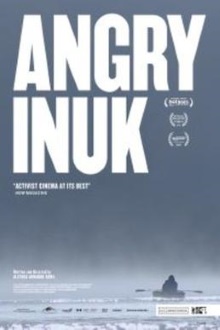
So the whole reason why I put this onto my list was because I heard about it on Broken Forum and I found the idea of an environmentalist documentary that argues in the opposite direction to be very appealing. It’s about the practice of seal hunting by the Inuit peoples and while we are familiar with campaigns against it, this documentary argues in favor of it.
The film begins with an undramatic depiction of what a seal hunt looks like. The hunter shoots and kills the seal at long range with a rifle then goes up to collect the floating carcass. It is immediately skinned, cleaned and gutted. The point of course is show that the kill is immediate and humane and every part of it is used by the Inuit. The entire film is written and narrated by its director Alethea Arnaquq-Baril, making it an impressive effort by mostly one person. She shows how her friends takes the skin and uses it to make clothing and how even Inuit children eagerly eat raw seal meat. An important topic is the European Union’s ban on seal hunting and how it caused the market in skins to crash. But by far the most explosive part of the documentary is its accusation that animal activists group are hypocritical in their campaigns against seal hunts, being motivated mainly by how easily it enables them to raise funding.
Though cheaply made and limited in scope, there is little doubt that Angry Inuk has been very successful in making a significant impact. The director is clearly savvy about social media and carefully chooses the correct words to appeal to a liberal, environmentally conscious audience. Personally, entreating that hunters contribute meat to the community as a whole and how tough life as a hunter is don’t work on me but facts like how the money earned from selling skins is essential for buying the fuel that allows hunters to even hunt in the first place do. I also liked how she showed that alternative food sources are crazily expensive due to having to be transported from elsewhere and that therefore meat from hunting remains a crucial part of the Inuit diet.As always, it’s wise to be appropriately skeptical when it comes to claims against groups like Greenpeace and the International Fund for Animal Welfare but the evidence she presents seems compelling and their repeated refusal to send someone to meet face to face with her is both telling and makes for a very powerful statement in its own right.
One weakness is that it does feel too much like the effort of a single person. Documentaries rely heavily on establishing the facts and in this case, it kind of matters what the population numbers for the Inuit are, exactly how reliant their economy is on the sale of seal skins and most importantly whether the seal population can support their preferred lifestyle. The director talks about all of this but doesn’t cite sources. The impact would have been far greater if she could have brought in outside authorities to speak to her, for example a scientist who is an expert in seals. I would also have preferred it if she more directly addressed the issue of the pain and suffering hunting causes seals. She dismisses the EU’s objections as the only justification they can come up with is on moral grounds. Yet as my wife pointed out, moral grounds do matter. Most people nowadays are very uncomfortable with the notion of eating dog meat including myself. Is that sort of concern unwarranted? One could argue that death is instant for the seals and so pain and suffering is minimized but I feel that it’s important to acknowledge this directly.
One thing that really gets me is how few the Inuk are, less than around 50,000 people. As my wife asks, it seems that it would cheaper for the outside world who cares about seals to pay to relocate them and offer them an alternative way of life. Still history has taught us that such programs never turn out well and the small numbers of the Inuk makes it easy to grant them a broad exemption. I still don’t understand why banning the commercialisation of seal skin by non-Inuk would crash the market when it should restrict the supply and drive up the price for the Inuk. It still seems to me that they are facing not mainly a legal problem but an image one of seal skin products being perceived as inherently immoral. Anyway judging by the impact this documentary has had, it’s hard to imagine the animal activists ignoring the Inuk now so best of luck to them.